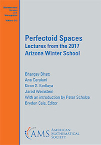- About MAA
- Membership
- MAA Publications
- Periodicals
- Blogs
- MAA Book Series
- MAA Press (an imprint of the AMS)
- MAA Notes
- MAA Reviews
- Mathematical Communication
- Information for Libraries
- Author Resources
- Advertise with MAA
- Meetings
- Competitions
- Programs
- Communities
- MAA Sections
- SIGMAA
- MAA Connect
- Students
- MAA Awards
- Awards Booklets
- Writing Awards
- Teaching Awards
- Service Awards
- Research Awards
- Lecture Awards
- Putnam Competition Individual and Team Winners
- D. E. Shaw Group AMC 8 Awards & Certificates
- Maryam Mirzakhani AMC 10 A Awards & Certificates
- Two Sigma AMC 10 B Awards & Certificates
- Jane Street AMC 12 A Awards & Certificates
- Akamai AMC 12 B Awards & Certificates
- High School Teachers
- News
You are here
Perfectoid Spaces: Lectures from the 2017 Arizona Winter School

Buy Now:
Publisher:
AMS
Publication Date:
2019
Number of Pages:
297
Format:
Hardcover
Series:
Mathematical Surveys and Monographs
Price:
129.00
ISBN:
978-1-4704-5015-1
Category:
Monograph
[Reviewed by , on ]
Emma Knight
08/29/2021
This book is an expanded and edited compilation of lecture notes from the 2017 Arizona Winter School on perfectoid spaces. The aim of the book and the corresponding winter school is to give graduate students in number theory a place to start learning about (and even doing research into) this new and exciting topic. I would be remiss if I didn't mention that there are video recordings of the lectures given at the winter school. These form a nice companion to the book.
This book is organized into four sections. The first section serves as an introduction to the base theory behind perfectoid spaces, and discusses the underlying theory of adic spaces and how this theory was used to construct the notion of perfectoid spaces. The second section goes into some more detail about the geometry behind adic and perfectoid spaces, and ultimately talks about how one would go about constructing moduli spaces of shtukas in mixed characteristic. The third section discusses \( p \)-adic Hodge theory through the lens of perfectoid spaces. It gives constructions of some of the classical period maps using the tools of perfectoid spaces before going on to discus some new period maps that were only constructed with the aid of perfectoid spaces. The final section is about perfectoid Shimura varieties and shows that infinite-level Shimura varieties are perfectoid. Various applications of this to the Langlands program are considered as well.
All four sections are very well written and do a good job of combining exposition, proofs, and examples. A lot of effort is made to relate newer concepts about perfectoid spaces to more classical objects and to provide the reader with intuition about how to think about perfectoid spaces. There are some inconsistencies between how the level of detail provided in each section, with some sections being a little light on detail and other sections being flush with all of the relevant details. In general, the book hits the mark in showing enough of the precise statements that underlie the theory without getting lost in the woods and losing track of the big picture.
A downside of the book is that there is a somewhat steep background assumption. While assuming familiarity with the \( p \)-adic numbers and some algebraic geometry are reasonable assumptions for someone wanting to study perfectoid spaces, the book has the passive assumption that the reader is also familiar with some of the more advanced concepts in algebraic geometry. For example, a couple of sections get into very detailed aspects of arithmetic geometry and \( p \)-adic Hodge theory. This book is undoubtedly a solid introduction for an arithmetic geometer, but may not be the best read for a graduate student just starting their number theory journey.
Emma Knight is a postdoctoral fellow at the University of Waterloo. Her research is in number theory, studying both the \( p \)-adic Langlands correspondence and \( \ell = p \) phenomena in arithmetic statistics.
See the publisher's website.
- Log in to post comments




